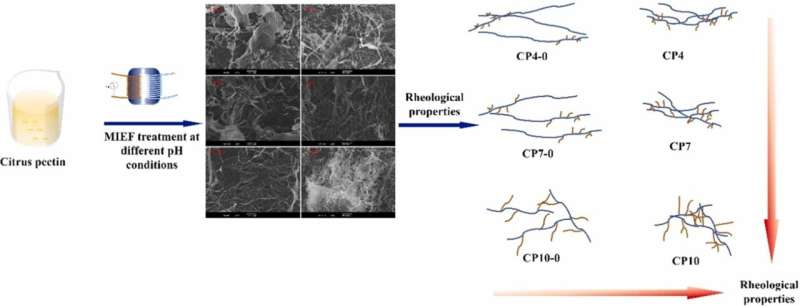This article has been reviewed according to Science X's editorial process and policies. Editors have highlighted the following attributes while ensuring the content's credibility:
fact-checked
proofread
Scientists modify citrus pectin with induced electric field

Pectin, a natural and nontoxic acidic polysaccharide, is widely found in the primary cell wall and inner layer of terrestrial higher plants. The main domains of pectin are homogalacturonan and rhamnogalacturonan I, which contribute to the complexity of structure among natural polysaccharides.
Pectin is widely used as a natural macromolecule in various applications, as a thickener, stabilizer, gel agent, texture modifier, microcapsule wall material and dietary fiber, as well as in special food design.
However, most pectin exists in the form of native pectin, which has a large molecular weight and limited solubility, restricting the practical application of pectin and necessitating its modification to meet specific requirements. The traditional methods of modifying pectin, including chemical degradation and enzymatic treatment, pose a potential threat to human health and safety.
In a study published in Food Physics, a team of researchers from the Dongguan Key Laboratory of Typical Food Precision Design at Dongguan University of Technology used magneto-induced electric field (MIEF) technology to explore the structural and rheological properties of citrus pectin under different pH conditions.
"MIEF was discovered in the early years for the invention of engines and can act on objects through non-thermal and thermal effects without direct contact, applying for the disinfection of microorganisms, as well as for the degradation and modification of polysaccharides," explains senior and corresponding author Jing-kun Yan.
"Notably, MIEF not only accelerates the reaction efficiency through the thermal action generated by working, but also promoted the movement of charged particles in the sample due to the electric field, as well as improves the rate and yield of chemical reactions."
The team's results show that as the pH increased to 4.0, 7.0, and 10.0, the molecular weight, degree of esterification, and galacturonic acid content of citrus pectin (CP) decreased accordingly, with MIEF treatment.
"At pH values of 4.0 and 7.0, MIEF treatment caused fractures in the side chains of CP, while at pH 10.0, the main chain broke," shares Yan. "MIEF treatment under these conditions enhanced the steady-state fluid behavior and dynamic viscoelastic properties of CP by promoting increased entanglements of neutral sugar side chains.
The study provides a green modification technique for CP and its application to functional foods.
More information: Ming-Yu Jin et al, Effect of magneto-induced electric field on the physicochemical, structural, and rheological properties of citrus pectin at different pH values, Food Physics (2024). DOI: 10.1016/j.foodp.2024.100021
Provided by KeAi Communications Co., Ltd.




















